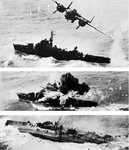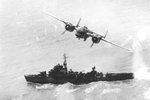oldcrowcv63
Tech Sergeant
Attached is a dramatic circa 1945 photo of a presumably lone B-25 bombing and sinking a maneuvering IJN destroyer Amatsukaze which IIRC had an incredible wartime career which exemplified the general prowess of IJN destroyer operations. The images of so many sailor-survivors struggling in the water evokes more sympathy today than it may have during the war… It looks like the photo bird (probably another B-25) didn't score a hit. There are also lots of what appear to be splashes in the photo indicating the presence of other allied a/c.
The fact that this sequence almost certainly didn't happen in the time it took to take three successive photos suggests a/c were hanging around to see the results of the strike.
Considering the horrible record of (not dive-bombing torpedo) aerial attacks against maneuvering Axis and allied marine targets, this seems to me to be a true image of one of the lessons learned during the war and how the evolution of tactics made all the difference in improving the general effectiveness of attacks. Level bombing from altitude in excess of 15,000' was pretty worthless but probably a bit safer for the aircrew facing ship borne AAA, while approaching the target and dropping ordnance at masthead height provided a higher hit probability but increased the crew to the possibility of a AAA Hit. Wonder if there might be an analogy here to the evolution and longevity of aerial torpedo attacks and also with the RN's experience during the Falkland Island campaign. Just wondering….
source: http://imgur.com/a/BQvIr#7T8dvfQ
The fact that this sequence almost certainly didn't happen in the time it took to take three successive photos suggests a/c were hanging around to see the results of the strike.
Considering the horrible record of (not dive-bombing torpedo) aerial attacks against maneuvering Axis and allied marine targets, this seems to me to be a true image of one of the lessons learned during the war and how the evolution of tactics made all the difference in improving the general effectiveness of attacks. Level bombing from altitude in excess of 15,000' was pretty worthless but probably a bit safer for the aircrew facing ship borne AAA, while approaching the target and dropping ordnance at masthead height provided a higher hit probability but increased the crew to the possibility of a AAA Hit. Wonder if there might be an analogy here to the evolution and longevity of aerial torpedo attacks and also with the RN's experience during the Falkland Island campaign. Just wondering….
source: http://imgur.com/a/BQvIr#7T8dvfQ
Attachments
Last edited:



